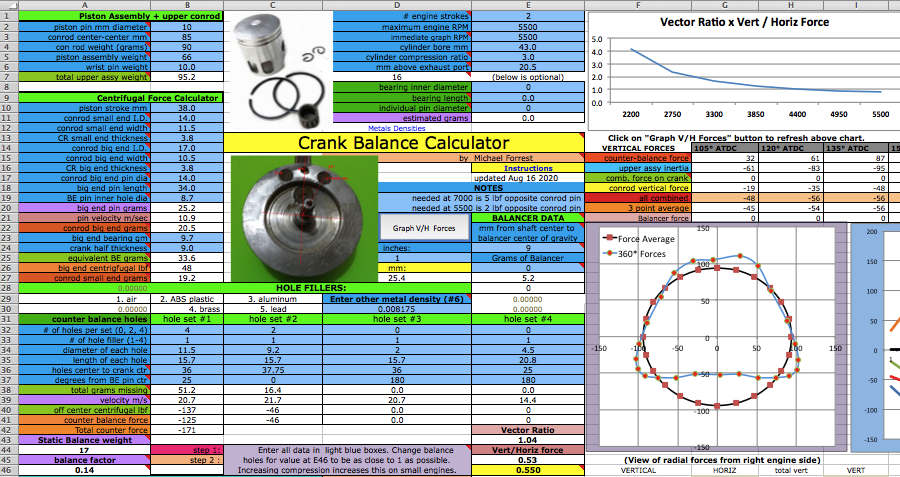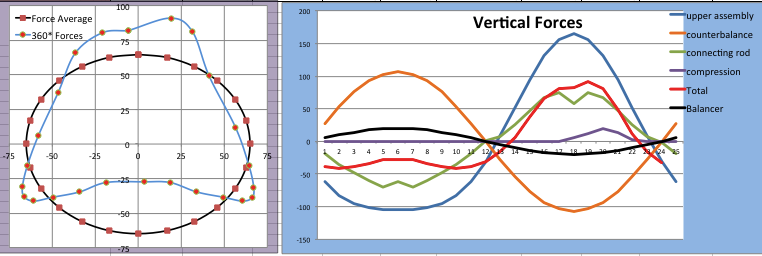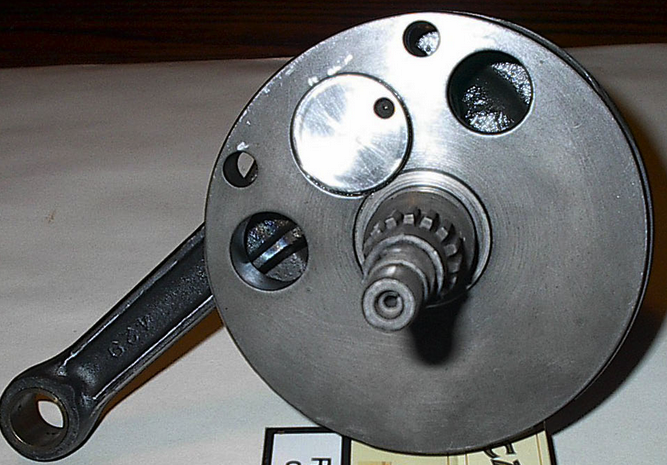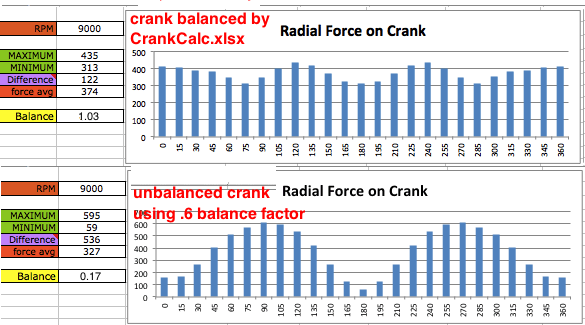 Some people will tell you it is impossible to balance the 2 stroke engine for little vibration but I’ve done it successfully and so have others. Most engines are fairly well balanced until the owner installs a non-standard piston or changes the compression ratio or rod length. What is “a little vibration”? It’s little enough that you can see what’s behind you in your handlebar-mounted rear view mirror because it’s not shaking. It’s also little enough that your hands and forearms don’t get fatigued just from the vibration. In one DirtRider magazine issue Rick Johnson was talking about his 1986 works CR250. He said: ”For example, the magic Honda always had was the cranks. There was something about those cranks- I can’t tell you what they did to them but when you got on and rode there was virtually no vibration to your hands." This proves that an excellent balance can be had for 250cc and smaller engines. The higher you go over 250cc the more vibration you get although the crank may have the best balance possible. A little vibration will always remain but if it is enough to bother you and you’re looking for ways to reduce the vibration at the bars then your engine needs some help. My ’89 KDX200 vibrated too much and fatigued my hands on long rides. I wish I still had it so I could balance the crank now that I know how. Click here for a simple way to test your crank balance. There are 4 “vertical” up/down forces in-line with the cylinder. They are: 1) upper assembly (piston assembly, wrist pin, conrod around the upper bearing) inertia 2) the centrifugal force of the heavier section of the crank wheels (opposite the balancing holes) counter-balances the upper assembly the closer it is to TDC and BDC. (subtracting from it is the centrifugal force of the conrod big end, the bearing, and the rod pin minus the lack of force from the rod pin holes in the crank wheels). 3) The connecting rod contributes to the value of the upward and downward force of the piston assembly. 4) The compression/combustion force also contributes. The 2 "horizontal" (forward/rearward) forces are: 1) the balance holes in the crank wheels offset the up/down piston assembly force but since there is nothing to counter balance it in the horizontal plane it can make vibrations if it's too much. 2) the connecting rod contributes around 5% of the value of the centrifugal force of the crank wheels to the horizontal. The piston assembly force is more around TDC because piston inertia is more there than around BDC due to the geometry created by the crank and connecting rod which causes maximum piston speed around 78 degrees before and after TDC. The upper piston assembly (piston, rings, end of con-rod, wrist pin, bearing) should be as light as possible because the unbalanced weight of the crank wheels can somewhat counter the forces in-line with the single cylinder but then create a fore/aft vibration due to lack of piston movement in that plane. If I’m analyzing an engine and I find that it needs a lighter piston assembly then I look at the wrist pin to see if it’s hefty enough to be able to drill out a larger diameter hole in it without causing it to be too weak for the engine. That lightens it up. Otherwise it’s just a matter of selecting the lightest aftermarket or OEM piston (such as Athena). If that’s not enough then the crank has to come out so balance holes can be drilled in it close to the connecting rod pin. I have made my own software that displays a graph of the vertical and horizontal forces and their combined result as radial forces throughout the 360 degrees of crank rotation. The goal is to counter-balance so the vibrational forces are as minimal as possible at peak RPM. The better the balance, the less rider fatigue which means more time of riding pleasure. My 55cc engine vibrated like crazy, and after drilling just two 9mm diameter holes in the crank wheels it was like normal. To use my crank balance calculator just enter in all the required data into the light blue boxes and then click the "Graph V/H Forces" button. The closer to perfect the balance is the smoother the ride will be and the less stress there will be on the crank bearings. Also less nuts and bolts will work themselves lose. Here are the graphs illustrating what good balance is:  The blue graph on the left shows the radial forces on the crank through 360 degrees of crank rotation. The reference zero point is where the x and y scales cross. The black graph is the average. The right graph shows the different vertical forces on the crank thru 360 degrees. The red graph is the sum of them all.  Below are the same graphs when an extra balancer shaft is part of the design. The black graph on the right is of the balancer force which typically is about 1/5th that of the counter balance force (due to the crank holes).   The best drill bits to use are carbide or cobalt. Here are some soures: Grainger carbide drill bits, cobalt drill bits (use 5/32” to make pilot hole then make the final hole.) McMaster-Carr has many carbide drill bits of high quality and can be used without a pilot hole. My YouTube videos about crank balance: #1 #2 #3 #4 The last video explains how to figure out the equivalent balance holes for a crank with sculpted out areas instead of balance holes. Questions and Answers  Does this work equally for 2 strokes and 4 strokes? Yes. When you enter "4" at E1 for a 4 stroke the program halfs the combustion force since the exhaust/intake stroke is without such force. Halving it is making it average out correctly for 4 strokes. Other than that everything is the same for 2 strokes and 4 strokes. Can this calculator be used for a crank that relies on true weights opposite the conrod pin? Yes it can. Just calculate with two counter balance holes with zero degree offset and when you have the final result for their right size then make the counter balance weights the same size as the imaginary holes. Are there any other programs available to do this? At this site is one available for $290 but I don't think it incorporates the combustion force. And I think they use the shitty old fashioned method of adding 60% of the con rod weight to the piston and 40% to the crank wheels. I think my program is the only one that painstakingly calculates correctly the con rod forces that are a significant contributor to the forces. Why do big bore engines vibrate more? Because the larger piston and conrod are heavier. The heavier they are, the more imperfect even the best balance becomes. But anything smaller than a 300cc engine should not make so much vibration that it tires out your hands. If you use the lead pellet trick instead of correcting faulty counterbalance then you are leaving the crankshaft bearings to be victimized by the extra radial forces on the shaft. Since the combustion force doesn't peak at TDC shouldn't the balance holes be a bit off center to compensate? Yes but I experimented with doing that and the result was just a very tiny bit of improvement, not really worth the extra effort. How does it calculate the balance? It uses a method that is only possible when the 360 degree forces are calculated. It multiplies the vertical/horizontal forces ratio to the ratio of force vectors every 120 degrees because both those are important. This is a genius program, as are most of my programs, and should be treated with respect although the price is low. Why is it so cheap? Although I have spent probably close to 100 hours developing it over 2 years I would rather many people have it than just a few. Unfortunately many people judge a product based on its price. Well if they knew me personally they would know I am off the beaten path and don't do things "normally" and so neither I or any of my products should be judged in a normal way. Here's a testimony from a satisfied user: " I have spent heaps of cash buying "balanced" cranks and "balanced bottom ends" [for a 69cc motorized bicycle engine]. Not cheap when shipped from the USA to Australia. I had two identical "jack-hammer" cranks and then bought this balance calculator. A GREAT investment. I did not trust estimating the con-rod weight, or the big-end or small-end sections of the con-rod for REAL accuracy. I stripped the crank to get EXACT measurements and weights. I cut off the big-end and small end (from a discarded conrod) to weigh them individually. The calculator is GREAT. You need to check your input figures and re-check them. Do not rush it. I found the experience very "addictive" and enjoyable. The crank when drilled with the calculated counterbalance holes has been proven to be my BEST CRANK. Jim Baker of OZ Motorised Bikes; a no bullshit facebook Group; where you find my posts about this." If you have an unanswered question then please shoot it to me at 19jaguar75@gmail.com 214,664 starting Jan 29 2017 |